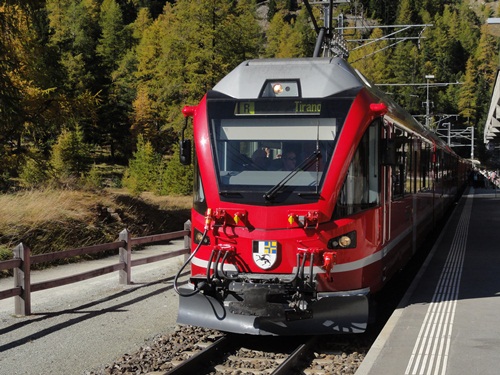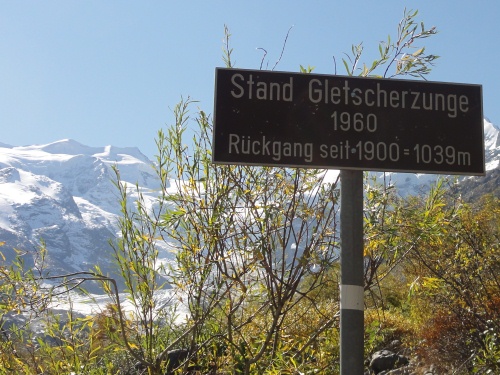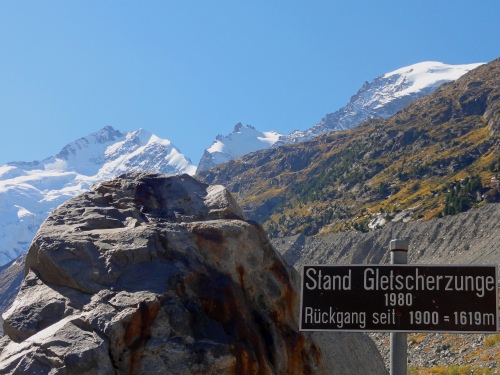SWITZERLAND
GLACIER RETREAT
|
ALL ABOUT SWITZERLAND |
|
MORTERATSCH GLACIER RETREAT |
|||||
|
Basic Tourist Information Travel Guide Sightseeing Landmarks · Swiss Tour · Chillon Castle · Rhine Falls · Monuments · Glaciers · Rhône Glacier · Morteratsch Glacier Alpine Resorts · Bernese Oberland · Zermatt/Matterhorn Swiss Cities · Basel · Bern · Geneva · Lausanne · Lucerne · St. Gallen · Winterthur · Zurich Activities · Summer Sports · Hiking · Winter Sports |
Global Warming Made VisibleMorteratsch Glacier Retreat
|
Morteratsch Glacier Retreat(since 1882)
From these figures it is absolutely evident that the local climate in the Bernina region has been continously warming since the end of the 19th century. Similar observations have been made troughout the Swiss Alps. | ||||||||||||||||||||||||||||||||||||||||||||||||||||||||||||||||||
When scientists began publishing first studies about global warming lots of people did not want to believe them and many even started to search for arguments that temperatures are still just within «normal» annual deviations from the average. Meanwhile their is enough evidence that global warming is a reality and glacier retreat is a visible proof for this reality that cannot be overseen any longer.
The debate has consequently switched from the question «is global warming real?» to the question «is global warming man-made?» The answer is - finally - crystal clear, but the arguments are not as simple as politicians and mass media might like them to be.
There ist no doubt that there are natural temperature cycles. First, a very long-term cycle with large effects on temperatures on the planet takes some 120,000 years from one minimum to the next and corresponds to what we call «Ice Age» periods. It has been shown that this cycle is related to the concentration of carbon dioxide (CO2) in the atmosphere. During at least four periods within the last 500,000 years temperatures were so low that glaciers covered large areas, for example Switzerland was completely covered by glaciers.
In fact, the «natural» cycle of Ice Ages is near the warm maximum currently. But, while the last three maximums showed carbon dioxide concentrations of 280 to 300 ppmv we face now a much higher CO2-concentration of more than 375 ppmv. In other words, a man-made increase in greenhouse gases adds to the natural cycle considerably.
Another known cycle is much shorter - only about 11 years from one maximum to the next and can be related to the activity of the sun. The energy emitted by the sun roughly corresponds to a phenomenon called «sun spots». While the cycle time is quite stable, maximum numbers of sun spots observed vary considerably from some 70 sun spots to some 200 sun spots, while the minima are always below 10 sun spots. Though short term changes in solar activity are a reality, there is no direct relation between sun spot cycles and global temperatures. The differences in solar energy emitted are simply too small compared to other short term effects on temperatures. Besides, the maximum of sun spots observed is at the end of the 1950's, followed by smaller peaks since. So the changes in solar activity as can be observed by the number of sun spots are not a relevant reason for global warming.
Global temperatures have been rising since the 19th century, however, and their average corresponds to the increase of concentration of greenhouse gases much better than to the natural ice-age cycles and to the height of sunspot cycle maximums.
Global Warming will lead to an almost complete loss of glaciers in many parts of the world, which will affect supply of drinking water and irrigation in periods without rain. This effect will be even more important because there will be more and longer periods without rain than today.
While there is also a risk of heavier thunderstorms, these will not compensate for the dryer periods, as most of the rain from heavy rainfall cannot be absorbed by the soil and will flow to the seas within a few weeks.
From Morteratsch railway station, a stop on the famous Bernina Railway Line leading from St. Moritz to Tirano (Italy), a path leads to the tongue of Morteratsch glacier. While the glacier used to you need now walk 2 km (1 1/4 miles) from the station to the glacier. A number of rocks and signposts marking the position of the glacier from 1878 to 20010 make the glacier retreat visible.
 Morteratsch train station |
 glacier tongue position in 1878 |
 glacier tongue position in 1900 |
 glacier tongue position in 1920 |
 glacier tongue position in 1940 |
 glacier tongue position in 1950 |
 glacier tongue position in 1960 |
 glacier tongue position in 1970 |
 glacier tongue position in 1980 |
 glacier tongue position in 1990 |
 glacier tongue position in 2000 |
 glacier tongue position in 2010 |
Morteratsch Glacier Photos     |

Short quotations allowed but with precise declaration of origin (Link).
Reproduction of substancial parts in printed or electronic form
only with explicit written consent by the editor.
| Disclaimer | www.all-about-switzerland.info © 2005 All Rights Reserved | Imprint | |